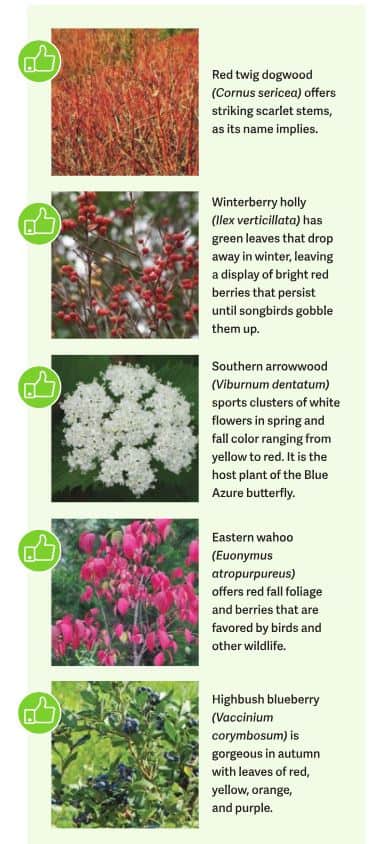Plant This, Not That.
June 1, 2023
Invasive burning bush
 Late last year, the Pennsylvania Department of Agriculture announced plans to ban the sale of burning bush, Euonymus alatus.
Late last year, the Pennsylvania Department of Agriculture announced plans to ban the sale of burning bush, Euonymus alatus.
Burning bush is an invasive species, meaning it is not native to our region and spreads without any natural checks. The plant originates from northeastern Asia and was brought to North America around 1860 as an ornamental shrub. Popular for its bright red fall foliage, the plant is spread by birds that carry berries into the woodlands where it crowds out native species, upsetting the forest ecosystem.
While burning bush will enjoy a grace period until January, 2025, when the ban takes effect, landowners can act now to remove and replace these shrubs on their property with native species. Not only will making the swap prevent invasive spread, the alternatives suggested on the right will improve the biodiversity in your landscape. They’ll attract beneficial insects that feed birds and small mammals.
Other recently banned plants in the Keystone State include Callery pear (Pyrus calleryana)—most commonly known for its cultivar ‘Bradford’—Asian and European privet species (Ligustrum sinense, Ligustrum japonicum, and Ligustrum vulgare), and Japanese barberry (Berberis thunbergia).
“To see how easily these invasive plants spread into natural areas, just hike into the woods anywhere around here. Our land stewardship staff and volunteers spend thousands of hours every year trying to manage invasive species on our preserves,” said Gary Gimbert, Natural Lands’ vice president of stewardship. “When they take hold, they create a monoculture. Native species can’t compete, which means the animals and insects that depend on the natives struggle for food and shelter.”
Gary added, “Hopefully people are beginning to realize that plants don’t care about property boundaries. So, if it’s in your yard, it’s also going to end up in forests and fields.”

next post
Dead Standing Tree Sculpture Means Life After Death
May 30, 2023
At Stoneleigh: a natural garden, a London planetree—close cousin to the native American sycamore—has towered over the Main House for more than 150 years. Its […]
continue reading